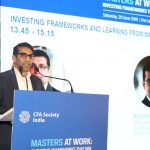- July 12, 2019
- Posted by: Shivani Chopra, CFA
- Category:BLOG, Events
Contributed by Soham Das, CFA

On 29th of June 2019, Kuntal Shah, founder of Pune based Oaklane Capital Management spoke on “Investing Frameworks and Learning from the Markets”. His talk covered over 300 years of financial market history and was filled with specific anecdotes of the major financial market crashes of history.
Spanning over 35 odd minutes, Mr. Shah walked the audience through bubbles and crashes, highlighting the extent to which investing public can and do go manic. His talk started with a declaration that “investing is the last liberal art” and pressed how investors should try to establish a mental latticework to figure out unfolding developments. He repeated, that navigating financial markets requires a composite knowledge of multiple knowledge domains, specifically an understanding of business cycle, economic cycle, investor psychology cycle, interest rates and fiscal cycle.
The first part of his talk focused on the investor psychology cycle. He remarked that there is a general tendency of fund managers to fail agreeably and “amicably”. In other words, failing by conforming is more accepted than staying out of the herd. Mr. Shah, credited, Ralph Wagner’s book, “A Zebra in the Lion Country” to highlight the difference between “eat-well” zone and “sleep well” zone. While, when fund managers herd, they sleep well, knowing that collective failure is acceptable, but content in settling for average returns. On the other hand, he quipped that, those fund managers who break out of the mould earn handsome returns.
Kuntal Shah, thrusted his point further when he focused exclusively on the idea that bubbles have to be navigated successfully to avoid the ensuing wealth destruction. Thus he pivoted completely towards analysis of financial bubbles.
He begun with the Tulip Mania of 1637, where the price of a gouda tulip soared 60x in 3 years. He pulled up a data table on the screen in front, which highlighted the extraordinary rise and price of a tulip bulb. At its peak, a bulb of tulip could have been exchanged vis a vis a fairly rich and big basket of essential commodities.
He talked through the bubbles and crashes of the next 200 years, and narrated out how seemingly geniuses like Isaac Newton, Charles Mackay etc. fell for them. Mississippi Bubble, South Sea Bubble, Railway Boom all were visited briefly, till he reached the episode of Great Depression.
He narrated how the errors in policy increased the pains of depression and lengthened the depression. Bringing out the folly of a trade war, he quoted history to remind audience of a particular tariff act called Smoot-Hawley Act, which deepened the crisis and delayed recovery from the Great Depression of 1929.
The mania of 1970’s US market, Japan Asset Bubble, Russian Crisis were showcased and interesting facts about each of those crises were narrated. To buttress his message, that valuations can soar extraordinarily high, he mentioned that during Japan’s real estate bubble, area around the Royal Palace was valued higher than the entire state of California.
Mr. Shah spent some time on the debacle of Long Term Capital Management (LTCM), Myron-Scholes team in LTCM and how their world-view differed, quite radically from that of Robert J. Shiller. He argued that the extent of volatility and frequency of extreme events in financial markets proved that Efficient Market Hypothesis doesn’t quite work as well as expected. When the turn for 2008 and the Global Financial Crisis came, he dwelled less on the study of the crash but more on the lessons he derived from them. His biggest lesson, he admitted was realizing how risk travels across the asset classes.
Profitless IPOs, peaking conspicuous consumption, rising frauds- all were signs as per him of an impending asset bubble. Veering towards investor psychology once again, he talked about the most dangerous 4 worded statement in investing – “this time is different”. This he mentioned is a general feeling often characterized by 3 composite world views: a, financial crisis is something that happens in other countries to other people, b, an overly and often unfounded faith in our own abilities to prevent a crisis and finally, a renewed confidence in our ability to predict one, long before it actually happens.
Mr. Shah’s slides intermittently recommended quite a few books, noteworthy among which were the following – “This Time is Different” by Kenneth and Rogoff and “Why it’s different this time”, by Robert Zuccaro, CFA. Both the books stand at the opposite end of their world view.
All the while, Mr. Shah reminded that, the hardest bubble to spot might be the one, that an investor finds himself in. He commented that expansion of a particular sector within an asset class can be a good sign of an impending bubble. Additionally, he considered the length of the tallest skyscrapers, magazine covers as “contra” indicators and symptomatic of an easy liquidity and an impending asset bubble. Signs of extreme behaviors at inflexion points were discussed at length by Mr. Shah. He listed out a pack of 13 signs that together can help to understand if, a market is showing signs of “topping” or “bottoming out”. A few of the ominous signs, as per him are, increasingly large number of IPOs, rapidly rising prices, excessive leverage, free availability of credit, unchecked optimism in popular media, historically high valuations and very high trading volumes, booming conspicuous consumption etc.
Conversely as per him, a few of the optimistic signs preceding a turnaround in the economy are,a complete absence of any activity in IPO market, M&A or VC arena, low valuations, official declaration of recessions, the fall of previously favorite sectors, low cost of credit etc.
Quickly spanning across Soros’s theory of reflexivity, Minsky model and 5 lens framework of Vikram Mansharamani, Kuntal Shah quickly landed on the topic of the current day. He highlighted that the elevated debt levels and rock bottom interest rates as the sources of risk in today’s world. Mr. Shah drew the attention of the audience towards a surprising fact – in 2018, 84% of all IPOs were of profitless companies.
He further plied on with his view that not everything is hunky dory by a slide which had “Easy Money and Congenial Interest Rates are necessary conditions for bubbles”, written boldly across the top. The slide showcased 4 panels of separate charts, that showed how valuations can rise extraordinarily and sharply during financial bubbles.
Wrapping up the presentation, Mr. Shah noted the following:
- Gold Standard, its absence or return is not the solution. Bubbles existed before its demise, bubbles will exist after it as well.
- Bubbles are decreasing in duration but increasing in frequency
- Inflation can rise quickly
- Fed Tightening event usually ends up with a financial event
In a moderated session with Raunak Onkar, the research head of Parag Parikh Financial Advisory Services, Kuntal Shah was asked by Onkar, how does he read the current market temperature as. Mr. Shah replied, that he sees signs of rising conspicuous consumption. He remarked, while unicorns are supposed to be rare, today they are a dime a dozen. He concluded his reply by adding, he does foresee the market becoming warm and frothy, and at the verge of a crisis.
Onkar, veered towards more specific ideas, when he asked Mr. Shah about his views of capital allocation skills of Indian promoters. Mr. Shah, declined to take names who are doing a good job, adding that he would rather not perform a hero worship as no one is infallible. However, he also added that majority of Indian CEOs are poor capital allocators.
In conclusion, Mr. Shah’s presentation talked in detail about the anatomy of bubbles, the mass psychology around them and the idea that human behavior is fallible. The three key takeaways from his talk was, while the general temperature of the market is rising, it is hard to say when the bubble will burst. Secondly, there are a handful of investors in Indian context who are doing capital allocation properly and finally, with investing being the last liberal art, it is important for us to have a sense of history to navigate the future.
Link to the full presentation – https://www.cfasociety.org/india/Presentations/History%20of%20Capital%20Markets-MAW%2029th%20June-Kuntal%20Shah.pdf







